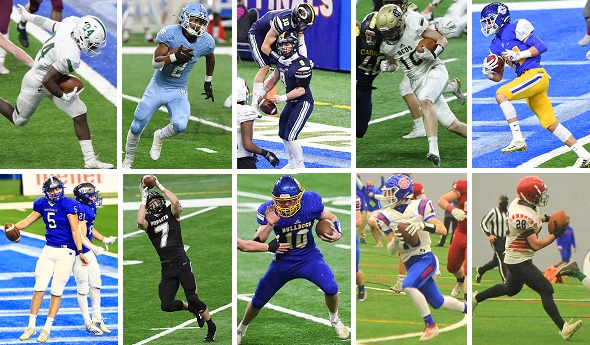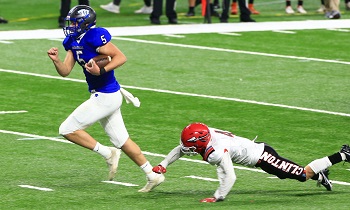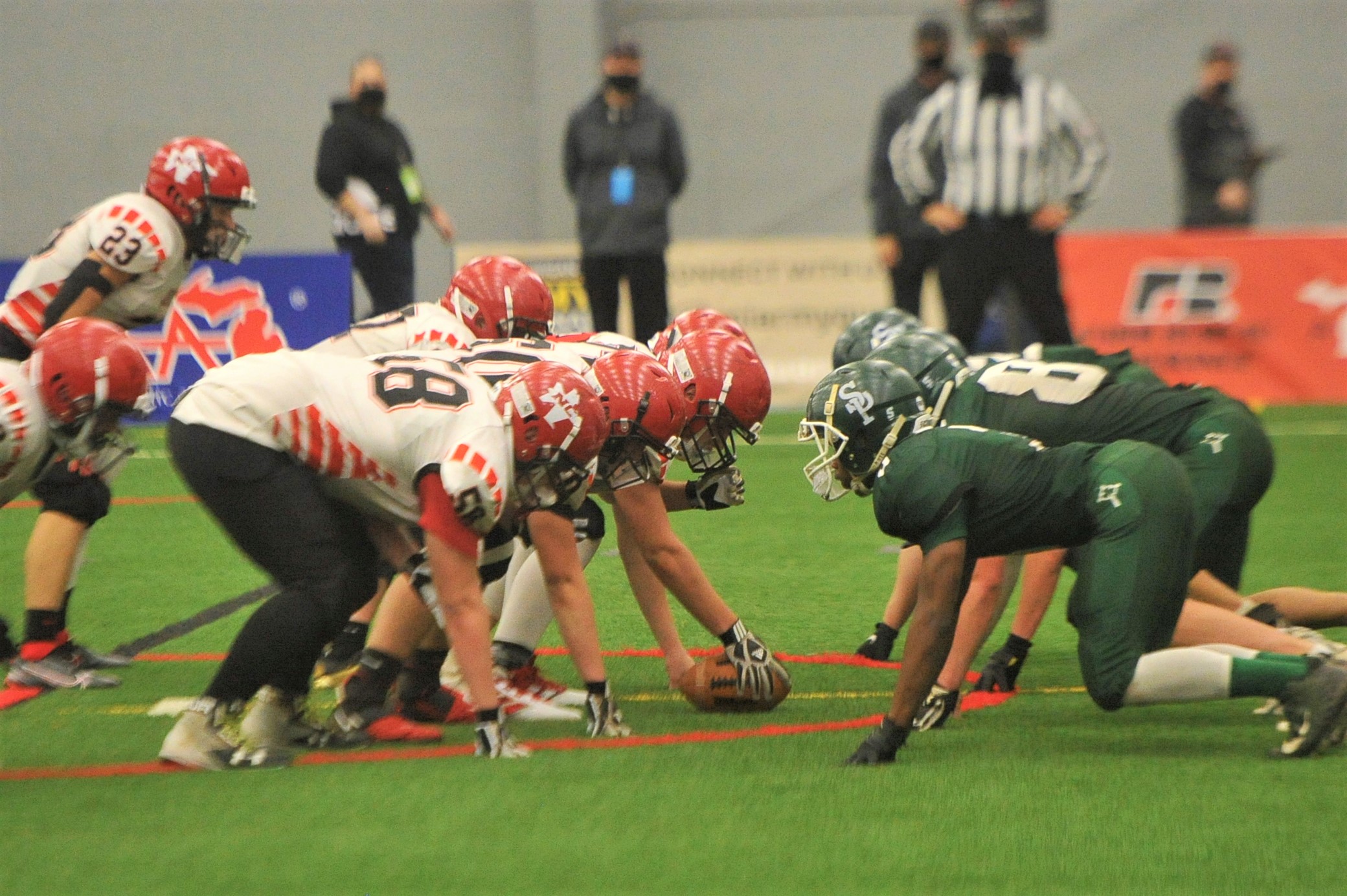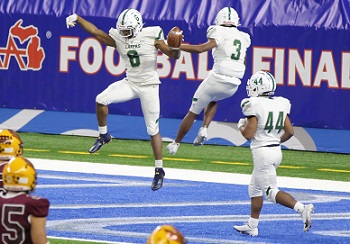
Inside Selection Sunday: Mapnalysis '13
October 28, 2013
By Geoff Kimmerly
Second Half editor
At the end of the day – Sunday, in this case – the 2013 MHSAA football playoff field was determined based on a set of numbers we began working with long before the first kickoff of this season.
So to kick off our discussion of how some of the 2013 playoff-selection decisions were made, here are a few numbers that might boggle the mind – or at least surprise:
- A total of 3,111 high school results were used in determining this season’s field – 2,978 for 11-player and 133 for 8-player games.
- We inputted and then followed the schedules for 623 MHSAA teams.
- We also inputted and followed weekly the schedules for 50 teams from surrounding states and Ontario that played at least one game against one of our MHSAA schools.
- We worked through complicated maneuverings made necessary by seven teams playing a mix of 11 and 8-player games, plus two more teams that played a mix of varsity and junior varsity opponents.
- And by Sunday morning we ended up with a few more numeric rarities: only 225 automatic qualifiers, the fewest since the current playoff system was introduced in 1999, and also an uneven number of at-large bids from our four classes because only six Class D teams reached the number of victories needed to be considered. (This was balanced by taking more at-large qualifiers from Classes A, B and C.)
And that was just the start of one of our most exciting days of the school year.
Following are more details. First, I explain some of the history of the MHSAA playoffs – I’ve lifted this in part from our 2012 report, so skip ahead if you’ve already got that down. Next, I touch on five themes that emerged as we built the brackets for this season’s tournament.
The process
Our past: The MHSAA playoff structure – with 256 teams in eight divisions, and six wins equaling an automatic berth (or five wins for teams playing eight or fewer games) – debuted in 1999, as mentioned above. An 8-player tournament was added in 2011, resulting in nine champions total when November is done.
That’s a long way from our start. The first playoffs were conducted in 1975 with four champions. Four more football classes were added in 1990 for a total of eight champions each fall. Through 1998, only 128 teams made the postseason, based on their playoff point averages within regions (four for each class) that were drawn before the beginning of the season. The drawing of Districts and Regions after the end of the regular season did not begin until the most recent playoff expansion.
In early years of the current process (or until the middle of the last decade), lines were drawn by hand. Dots representing qualifying schools were pasted on maps, one map for each division, and those maps were then covered by plastic sheets. Districts and Regionals literally were drawn with dry-erase markers.
Our present: After a late Saturday night tracking scores, we file in as the sun rises Sunday morning for a final round of gathering results we may still need (which can include making a few early a.m. calls to athletic directors). Then comes re-checking and triple-checking of enrollments, what schools played in co-ops, some records and more before the numbers are crunched and the fields are set.
Those 256 11-player teams are then split into eight equal divisions based on enrollment, and their locations are marked on digital maps that are projected on wall-size screens and then discussed by nearly half of the MHSAA staff plus a representative from the Michigan High School Football Coaches Association. Only the locations themselves are marked (by yellow dots) – not records, playoff point averages or names of the schools or towns. In fact, mentions of those are strictly prohibited. Records and playoff points are not part of the criteria. Matchups, rivalries, previous playoff pairings, etc. also DO NOT come into play. The same process is followed for organizing the 8-player bracket.
Observations and answers: 2013
This doesn’t happen overnight: Preparation for selecting the MHSAA playoff field begins long before the first kickoff of fall, much less the first practice. We load schedules for all 600-plus varsity teams during the summer, and many schedules remain fluid right up until the first Friday of the season – and this fall, a few weren’t settled until Week 2 or 3.
This summer as in some past we also worked through schools closing (Inkster, Saginaw Buena Vista, Detroit Northwestern, Flint Northern), and others deciding in mid-July and early August they would not field teams because of a lack of players.
Sometimes we have to take odd paths to find scores for these games. The last 11-player score to be added to our data this regular season came in as a result of tweeting the sports anchor of a Wheeling, W.Va., television station. Our last 8-player score came in via email from a Wisconsin athletic director at 10:30 Saturday night. Thankfully, we get plenty of assistance from some of our friends in the field, who keep an eye on the data and alert us when something appears missing or incorrect.
Win and advance: This season’s list of 5-4 teams includes a number of heavy hitters that did not receive at-large bids – East Grand Rapids, Utica Eisenhower, Orchard Lake St. Mary’s and Flint Powers Catholic to name a few. All were solid teams and played strong competition. All missing the playoffs likely raised some eyebrows.
But we have to take a look at this from a statewide view. There admittedly can be some argument about what schools qualified for the 226-256 spots in the field – but the important part is that 225 qualified because they all met the minimum win requirement. A playoff is simply that – it decides a champion based on teams winning. For some it’s harder to pile wins, of course, because they play in tough leagues. But the winners of those leagues are in the field – and surely will credit that tough road with getting them prepared to now play the state’s best.
Geography rules: This long has been rule number one for drawing MHSAA brackets in any sport, and is a repeat as well for those who have read this report the last two Octobers. Travel distance and ease DO come into play. Jumping on a major highway clearly is easier than driving across county-wide back roads, and that’s taken into consideration.
Also, remember there’s only one Mackinac Bridge and hence only one way to cross between peninsulas – and boats are not considered a possible form of transportation. When opponents from both peninsulas will be in the same District, distance to the bridge is far more important than as the crow flies.
The best example of this comes this season in Division 5. Grayling clearly is east of both Kingsley and Kalkaska – but also sits on I-75, while those two do not. So while those more western teams are geographically closer to Houghton, Menominee and Kingsford from the Upper Peninsula, we instead paired the three U.P. teams with Grayling because being on a main highway made for a shorter trip. The trip to Grayling for any of those U.P. teams would be 36 miles shorter to Grayling than Kingsley and 13 miles shorter to Grayling than Kalkaska.
Sometimes it’s where the points aren’t: Sure, it would be best-case scenario to have perfect sets of eight dots split into four quadrants from Calumet to Bedford. But generally that doesn’t occur. “Dots determine the map” is a common phrase heard here during this selection process, but that works the other way as well. If there are no qualifiers in a division from a specific area of the state – see Division 1, with none south of Holland or west of the greater Lansing area – there’s no choice but to create the unusual Regional Final possibility of Traverse City West vs. Brighton. Brighton is simply closer to the west side of the state than our other options.
Border to border vs. coast to coast: Should Regions be grouped north to south or east to west? There isn't a right or wrong answer – it just depends on that set of dots.
Whenever we have Upper Peninsula teams in a division, they’ll be grouped with those from the northernmost points of the Lower Peninsula for a District. The next northernmost schools will be grouped into a District, and together those eight will form a Region.
But the tough decision comes with the other six Districts. Look at this season’s Division 5 map: Six Districts are grouped south of U.S. 10 with three near or west of U.S. 127 and three east of that highway, which runs through the center of the Lower Peninsula. We grouped the two southwestern Districts into a Region and the two southeastern Districts into a Region – leaving a final Region that stretches from Muskegon on Lake Michigan to Almont, about 35 miles west of Lake Huron.
That’s a haul. But it’s also the best of our possible compromises. We could’ve instead paired regions that would’ve stretched from Hopkins to Monroe – only 19 fewer miles in distance than Muskegon Oakridge to Almont, but a scenario that could’ve created travel increases for a number of additional teams. Another option included a possible trip from Detroit University Prep to Freeland, which also would take more than two hours.
Bottom line – it’s been written here before – we pour all we have into this process, asking questions often more than once until we come up with a consensus. We do appreciate the arguments that arise once brackets are released to the public: The discussions are proof of how much players, coaches and fans care – and often show us new ways we can look at a system that’s now 15 years old.
But we must remember that the good news is the tournament is still set up to reward nine champions over the next five weeks, and five schools – Auburn Hills Oakland Christian, Coldwater, Detroit Allen, Eaton Rapids and Muskegon Mona Shores – will be competing for those titles for the first time.
It’s not so much how the tournament starts as how it ends. And we’re preparing for nine more memorable conclusions.
PHOTO: Each collection of grouped dots is a District on this season's Division 3 playoff map.

1st & Goal: Finals in Review
January 28, 2021
By Geoff Kimmerly
Second Half editor
With absolute certainty, we can say this recently-concluded football season was like no other during the nearly 100-year history of the MHSAA.
But after just more than five months, and amid COVID-19, it was played to completion – with 8-Player Finals on Jan. 16 at Brighton’s Legacy Center and 11-Player Finals Jan. 22-23 at Ford Field in Detroit.
Second Half again covered all 10 championship games, with quick recaps and links (click on the game scores) to those stories below followed by notations of performances entered into the MHSAA Finals record book and a report on some of the biggest and best stories to emerge from the championship weekends. See also below highlights from State Champs Sports Network.
Finals in Review
11-Player Division 1: West Bloomfield 41, Davison 0
Led by Donovan Edwards’ 257 yards and three touchdowns rushing, West Bloomfield won its first Finals championship with a shutout of the 2019 champion Cardinals. Much more on Edwards below, but the Lakers’ effort on the other side of the ball can’t be overlooked – the shutout was the team’s sixth of the season.
11-Player Division 2: Muskegon Mona Shores 25, Warren De La Salle Collegiate 19
After winning its first championship in 2019, Mona Shores earned another in its encore led again by quarterback Brady Rose. Rose had started last season’s Final in place of an injured all-stater, but he was hardly unknown this time – and still ran for 154 yards and two touchdowns, including a 65-yard sprint during the fourth quarter that helped wrap things up for the Sailors.
11-Player Division 3: DeWitt 40, River Rouge 30
DeWitt finished off the longest football season in MHSAA history with its first championship, earning it against a River Rouge team looking to repeat after winning its first title in 2019. Quarterback play was on display in this finale as well, with DeWitt’s Tyler Holtz and Rouge’s Mareyohn Hrabowski putting up big numbers.
11-Player Division 4: Detroit Country Day 13, Cadillac 0
With youngest son Danny a major contributor, Country Day coach Dan MacLean led the Yellowjackets to their first Finals championship since 1999. Country Day kept first-time finalist Cadillac to just 166 total yards, and the shutout was the Yellowjackets’ third straight.
11-Player Division 5: Grand Rapids Catholic Central 48, Frankenmuth 21
The Cougars added their fourth championship in five seasons, this one their first in Division 5 after winning previously in Division 4. GRCC quarterback Joey Silveri accounted for six touchdowns in a Final for the second-straight season as his team built a big early lead against the first-time finalist Eagles.
 11-Player Division 6: Montague 40, Clinton 14
11-Player Division 6: Montague 40, Clinton 14
Strong quarterback play and a father-son connection both came into play in Division 6 as well as senior Drew Collins led dad Pat’s team to its first Finals championship since 2009. What Drew said after told the story of the entire season restart: “Everybody on this football team, coaches, players, trainers – everybody on this football team loves high school football. I love high school football. I love these coaches. I love my friends on the team. I love everybody on the team. I love the community. It’s bittersweet when you win a state championship when you’re a senior because it’s all over.”
11-Player Division 7: New Lothrop 42, Traverse City St. Francis 35
The Hornets’ Julius Garza put up one of the most impressive individual performances of the weekend, scoring three ways for a total of four touchdowns. New Lothrop got up early and then held off a St. Francis comeback to claim its second championship in three seasons.
11-Player Division 8: Centreville 22, Ubly 0
Centreville’s shutdown defense put together one more awe-inspiring performance to help the Bulldogs’ to their first championship. Centreville ran its state-best points-allowed-per-game average to 2.9 with its seventh shutout in 10 games played.
8-Player Division 1: Adrian Lenawee Christian 47, Suttons Bay 0
The Cougars put an exclamation point on a dominating first season of 8-player football with their first Finals championship in the sport, either format. Lenawee Christian not only performed well offensively but held Suttons Bay to 52 yards total. The Norsemen finished Division 1 runners-up for the second-straight season.
8-Player Division 2: Powers North Central 70, Portland St. Patrick 48
The Jets claimed their third championship in what was the highest-scoring 8-player championship game in the decade-long MHSAA Finals history of this format. More on that below, and also on North Central quarterback Luke Gorzinski and St. Patrick quarterback Connor Cross, who were among those to put up giant numbers. The Jets also feature a father/son combo, with Luke the son of head coach Leo Gorzinski.
Records Report
As one might imagine, the highest-scoring game in 8-Player Finals history was filled with record book accomplishments. North Central’s 70 points were the 8-Player Finals record for one team, and the combined 118 points were 19 more than the previous record set in Peck’s 67-32 win over Rapid River in 2013. The teams’ 933 combined total yards ranks third on that 8-Player Finals list, while North Central’s 22 first downs was tied for second and St. Patrick’s 21 first downs ranked fourth. Neither team punted, making for another first in 8-player championship games. The game was not only the highest-scoring 8-Player Final, but the third-highest scoring 8-player game in MHSAA history (including regular season), missing tying that record by only six points.
 Also as noted above, all-state quarterback play was on display for both 8-player Division 2 finalists. North Central QB Luke Gorzinski totaled the second-most rushing yards, 299, in an 8-Player Final, and with 156 yards passing set the total offense record at 455. St. Patrick QB Connor Cross, with 397 total yards, is fourth on that list. Cross’s 374 passing yards were second-most in an 8-Player Final, as were his six passing touchdowns, and he earned the first listings with 25 completions and 38 pass attempts. Shamrocks receiver Shane Cook, meanwhile, set the record with 13 receptions for the second-most receiving yardage, 179. North Central as a team finished with the third-most rushing yards, 373 on 37 attempts, and third-most rushing touchdowns with six. St. Patrick as a team was second for team passing yards and touchdowns.
Also as noted above, all-state quarterback play was on display for both 8-player Division 2 finalists. North Central QB Luke Gorzinski totaled the second-most rushing yards, 299, in an 8-Player Final, and with 156 yards passing set the total offense record at 455. St. Patrick QB Connor Cross, with 397 total yards, is fourth on that list. Cross’s 374 passing yards were second-most in an 8-Player Final, as were his six passing touchdowns, and he earned the first listings with 25 completions and 38 pass attempts. Shamrocks receiver Shane Cook, meanwhile, set the record with 13 receptions for the second-most receiving yardage, 179. North Central as a team finished with the third-most rushing yards, 373 on 37 attempts, and third-most rushing touchdowns with six. St. Patrick as a team was second for team passing yards and touchdowns.
Gorzinski wasn’t the only offensive star for the Jets; teammate Wyatt Raab finished with the third-most points scored in an 8-Player Final, 32, on four touchdowns, three two-point conversions and a safety. Gorzinski did finish with the fourth-most points, 28, on four touchdowns and two two-point conversions. Both made the total touchdowns list with four apiece.
The 8-Player Division 1 Final made the record book as well, in two categories. Lenawee Christian as a team defense posted the lowest number of yards allowed, just 52. And Cougars quarterback Landon Gallant also made the total offense list with 326 yards – 59 rushing and 267 passing.
New Lothrop’s Julius Garza was among individual standouts from the 11-Player Finals, tying for fourth with 26 points scored – on four touchdowns and a two-point conversion – and also tying for fourth for touchdowns in a game, in Division 7.
West Bloomfield’s Jake Ward made all three kicking lists for 11-player, tying for third with two field goals in a game, ranking fourth for longest with a 45-yarder, and making the extra points list with five in the Division 1 Final. Grand Rapids Catholic Central’s Jack Barlow tied for fourth on that extra points list with six in the Division 5 game.
The Lakers’ Donovan Edwards was another of the stars of the weekend, with his 257 yards rushing ranking eighth all-time for an 11-Player Final – and while coming on just 14 attempts in Division 1.
Montague’s Drew Collins made the 11-player passing yards list with 244, coming on 15 completions in the Division 6 game. Three of those went for touchdowns to teammate Samuel Smith, who tied the record held by nine others for touchdown catches in an 11-Player Final.
DeWitt quarterback Tyler Holtz tied for fifth on the passing touchdowns list with four in Division 3. Opposing quarterback Mareyohn Hrabowski from River Rouge made the total yardage list with 321 – 94 rushing and 227 passing. New Lothrop’s Cam Orr also made the total yardage list with 344 – 122 rushing and 222 passing.
While quarterbacks starred in many cases, the run game was hardly left behind. In addition to Edwards’ performance for West Bloomfield, Clinton had the fifth-most rushing attempts in 11-player championship game history with 65, for 358 yards. Clinton also tied the record with just one pass attempt, with West Bloomfield tying for fifth on that list with two throws. Those two and Cadillac all tied the 11-Player Finals record by recording zero completions – they brought that all-time list to 21 teams that didn’t complete a pass in an 11-player title game.
Grand Rapids Catholic Central in Division 5 also became the 28th 11-player finalist to go an entire game without punting.
 The Division 6 Clinton/Montague matchup also finished as one of the least-penalized in MHSAA 11-Player Finals history. The two teams combined for just 10 penalty yards, coming on one Clinton penalty. Montague was not penalized in the game.
The Division 6 Clinton/Montague matchup also finished as one of the least-penalized in MHSAA 11-Player Finals history. The two teams combined for just 10 penalty yards, coming on one Clinton penalty. Montague was not penalized in the game.
Stories Behind the Scores
The Longest Season: Due to COVID-19, this season started on time, stopped, restarted, stopped again in mid-November, and restarted one more time with rapid testing the final week of December with playoffs ending over two weekends in mid-January. There are many reasons to want to forget the last year, and many much sadder circumstances. But the perseverance of all Fall athletes and families, coaches, administrators and support staff; along with the testing program provided by the Michigan Department of Health and Human Services, made for a memorable story that surely will be recalled for years to come.
First finishing 1st: West Bloomfield in 11-Player Division 1, DeWitt in Division 3 and Centreville in Division 8, and Adrian Lenawee Christian in 8-Player Division 1 all won their first MHSAA Finals in this sport. Cadillac in Division 4 and Frankenmuth in Division 5 made their first championship game appearances.
Edwards’ excellent ending: Edwards was slated to join University of Michigan’s football program as an early enrollee in January. But first, he wanted to finish his high school season, and career, with the Lakers. He led them to their first championship, with one of the top rushing performances in Finals history, and as arguably the biggest headliner from the weekend at Ford Field – likely gaining a few more fans along the way as well.
Many ways to win: As noted above, defense still works – four of 10 Finals were shutouts, and Centreville’s season-long performance was incredible. Also noted above, champions won both running and passing. But a final fun note on offense – seven of 10 champions this season scored 40 or more points in their championship games. That’s compared to two in 2019, five in 2018 and five in 2017.
(Click for more photos from Hockey Weekly Action Photos.)

